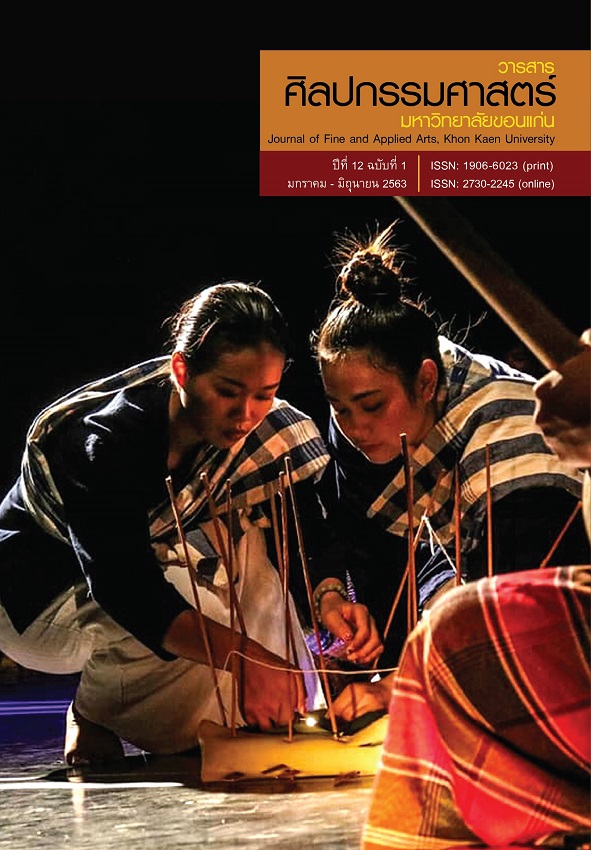Sud Sanan-Sawatthee: Designing Community-based Theatre Activities and Making Performance for Telling Collective Memory of Isan People
Main Article Content
Abstract
The research project of Sud Sa Nan-Sawatthee: Creating Contemporary Performance from Cultural Capital for Telling Collective Memory and Values of Isan Community; A Case Study of Sawatthee Community, Muang district, Khon Kaen province aims to find the strategy for designing community-based theatre activities and create a contemporary performance about memory. Then, there are the creation of corrective memory together with participants through the process of community-based theatre. In the mean time, created contemporary performance by cultural capital in community and present to Isan audiences. The process is divided into 2 phases. Firstly, practice in community: it is the design of drama activities and used to community-based theatre process at Sawatthee community. Secondly, to develop a production of contemporary performance titled “Sud Sa Nan” and to present in Performing Arts Studio, Faculty of Fine and Applied Arts at Khon Kaen University. The results found that drama activities are designed and used in the research process which can make participants to remember memories of themselves and community both sensory memory, short-term memory and long-term memory. The participant memories can present through process-drama titled “Sud Sa Nan-Sawatthee” for telling memory, history and voice of group to audiences in community. However, the corrective memory occurred during the process of drama activities which can develop to the contemporary performance titled “Sud Sa Nan” to tell about idea, perspective and sensibility towards the Sawatthee community. Moreover, to present concepts of a new generation Isan people through a performance by drama students at Khon Kaen University.
Article Details
Content and information in articles published in the Journal of Fine and Applied Arts of Khon Kaen University is regarded as the opinion and sole responsibility of the author(s) directly; therefore, editors are not obliged to agree to or share any responsibility with regard to the content and information that appears within these articles.
All articles, information, content, image, etc. that have been published in the Journal of Fine and Applied Arts of Khon Kaen University is the copyright of the Journal of Fine and Appllied Arts of Khon Kaen University. Any person or organization who wishes to distribute all or parts of the articles for further dissemination or other usage must first receive permission from the Journal of Fine and Applied Arts of Khon Kaen University before proceeding to do so.
References
กนกพันธรน์ โลกุตรวงศ์. (2555). การจัดการช่องว่างระหว่างวัยเพื่อการพัฒนาทรัพยากรมนุษย์ในองค์กร. วารสารปัญญาภิวัฒน์, 3(2), 132-143.
ฉัตรทิพย์ นาถสุภา. (2557). การเป็นสมัยใหม่กับแนวคิดชุมชน. กรุงเทพฯ: สร้างสรรค์.
ชัยพร วิชชาวุธ. (2520). ความจำมนุษย์. กรุงเทพฯ: ชวนพิมพ์.
ชาญวิทย์ เทียมบุญประเสริฐ. (2528). การวัดความถนัด. กรุงเทพฯ: สำนักทดสอบทางการศึกษาและจิตวิทยา มหาวิทยาลัยศรีนครินทรวิโรฒ.
ปิ่นแก้ว เหลืองอร่าม. (2561). วาทะทางทฤษฎีในมานุษยวิทยา. วารสารมานุษยวิทยา, 1(2), 7-70.
พรรัตน์ ดำรุง. (2557). ละครประยุกต์ การใช้ละครเพื่อการพัฒนา. กรุงเทพฯ: จุฬาลงกรณ์มหาวิทยาลัย.
พรรัตน์ ดำรุง. (2562). บทตั้งต้น. ใน พรรัตน์ ดำรุง (บรรณาธิการ). ข้ามศาสตร์ ข้ามเวลา. (หน้า 8-48). กรุงเทพฯ: ภาพพิมพ์.
พัฒนา กิติอาษา. (2557). สู่วิถีอีสานใหม่. กรุงเทพฯ: วิภาษา.
มาลินี จุฑะรพ. (2539). จิตวิทยาการเรียนการสอน. พิมพ์ครั้งที่ 2. กรุงเทพฯ: ศูนย์ส่งเสริมวิชาการ.
วชิรวัชร งามละม่อม. (2558). ทฤษฎีภาวะทันสมัย (Modernization theory). ค้นเมื่อ 1 สิงหาคม 2562, จาก http://learningofpublic.blogspot.com/2015/09/modernization-theory.html
วิกิพีเดียสารานุกรมเสรี. (2563). ความจำ. ค้นเมื่อ 1 สิงหาคม 2562, จาก https://th.wikipedia.org/wiki/ความจำ
วินัย บุญลือ. (2545). ทุนทางวัฒนธรรมและการช่วงชิงอำนาจเชิงสัญลักษณ์ของชุมชนชาวปกาเกอะญอ. วิทยานิพนธ์ปริญญาศิลปศาสตรมหาบัณฑิต สาขาพัฒนาสังคม บัณฑิตวิทยาลัย มหาวิทยาลัย เชียงใหม่.
สุภางค์ จันทวานิช. (2555). ทฤษฎีสังคมวิทยา. กรุงเทพฯ: สำนักพิมพ์แห่งจุฬาลงกรณ์มหาวิทยาลัย.


